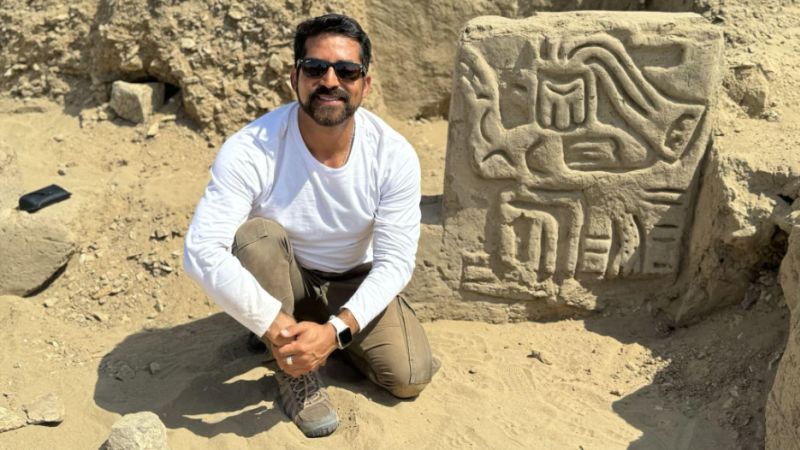Archaeologists in Peru have unearthed a 4,000-year-old temple and theater. The find will provide new informations into the origins of complex religions in the region. This discovery predates Machu Picchu by about 3,500 years.

Also Read: Pistols Napoleon Planned for Suicide Sold for $1.8 Million in France
The site was La Otra Banda, Cerro Las Animas was first studied in June. Located near the northern town of Zaña, the site was identified after local reports of looting.
The excavation covered an area approximately 33 feet by 33 feet. Initial findings included ancient mud and clay walls just six feet beneath the surface.
The team uncovered a section of a large temple. One of the most important finds was a small theater with a backstage area and a staircase leading to a stage-like platform. The theater likely hosted ritual performances for a select audience.
A staircase in the theater featured mud panels with elaborate carvings of a mythological bird-like creature.
These carvings are reminiscent of designs from the Period (2000-900 BC). Such artifacts provide clues about the temple’s age.
The temple and theater are older than other famous Peruvian sites like Machu Picchu, which dates back to the 15th century.
The find predates other pre-Inca cultures such as Moche and Nazca. These early structures indicate religious and political systems long before these later civilizations.
The team also discovered several large murals painted on the temple walls. Samples of paint pigments have been collected for laboratory analysis and carbon dating. Human skeletal remains linked to religious rituals and were found within the temple.
The discovered structures date back to around 2000 BCE during the Initial Period, a time recognized for the emergence of institutionalized religions in Peru.
The excavation was prompted by alerts from the local government regarding looting activities near Zaña. The excavation was led by Dr. Luis Muro Ynoñán from the Field Museum.
Situated near the northern coast of Peru close to the city of Chiclayo. Archaeologists selected a 10 by 10-meter plot and gradually removed layers of sediment reaching a depth of about 1.8 meters uncovering ancient walls made of mud and clay.
Also Read: 51,000-Year-Old Artwork Discovered in Indonesian Cave
Intricate carvings were found on mud panels depicting a mythological bird creature with both anthropomorphic and reptilian features.
This design is essential in understanding the cultural narratives of the time. The discovered figures bear resemblance to later representations found in the Chavín region which could illuminate the evolution of religious practices in ancient Peru.
The Initial Period (circa 2000 to 900 BCE) is the first signs of institutionalized religion in Peru. The Preceramic Period (5000-3000 BCE) saw the emergence of early societies along the coast setting the stage for more political structures.
This archaeological site predates Machu Picchu, which was built around the 15th century CE by the Inca Empire.
Dr. Ynoñán, stated, “This discovery tells us about the early origins of religion in Peru.”
Peru is rich in archaeological sites from pre-Hispanic times. The discovery of a 4,000-year-old temple in the Zaña district adds to the understanding of early Andean civilizations.
Previous finds include a 3,000-year-old tomb likely honoring an elite religious leader and a 1,000-year-old adolescent mummy in Lima.
The newly discovered temple walls feature drawings of mythological figures. These figures with human bodies and bird heads, predate the Chavin culture which thrived around 900 BC.
Another nearby excavation revealed remains of a temple from the Moche culture approximately 1,400 years old.
Northern Peru hosts the Sacred City of Caral, an ancient ceremonial complex about 5,000 years old.
Southern Peru’s Ica region is known for the Nazca lines, mysterious geoglyphs over 1,500 years old. Machu Picchu was built in the mid-15th century and is a World Heritage site.
Also Read: Aswan: Archaeologists Discover Over 1,400 Mummies in Egypt























